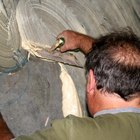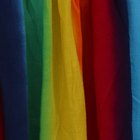Lye, or sodium hydroxide, is most commonly found in hair care products, particularly those intended to straighten tresses, as well as in drain cleaners and soaps. While lye breaks up sticky stains and is used to remove some substances, it is reactive to many chemicals and can stain or damage clothing and carpets when applied directly, when not used as intended, or when a product is spilled. There are chemical-based methods for removing lye stains, as well as a vinegar method. The sooner the stain is treated, the more successful the removal will be.
Stain Solution Method
Put on gloves to protect your skin before you address the stain.
Cover the stain with a clean cloth and gently press to blot. Refrain from scrubbing as it may damage the fabric or help set the stain.
Vacuum dried residue if present.
Squirt a small amount of commercial stain pretreatment or spot removal solution to the stain to test colorfastness. Carpet or upholstery may come with a recommended product at time of purchase. For clothing, use a laundry pretreatment solution. Alternately, test the solution in an inconspicuous area. If clothing is affected, test on an inside seam. If the spill happened on carpet, test in an unobtrusive area, such as where the carpet lines a closet floor.
After several minutes, saturate a clean cloth with cold water and use it to blot and remove the solution. If material retains its color, proceed to stain treatment.
Treat the stain with pretreatment solution. Spread, but do not rub, solution into affected fabric with a clean cloth.
Repeat Step 5 until stain has dissipated to your satisfaction.
Saturate a clean cloth with cold water and use it to blot and remove the solution.
Cover the previously stained area with a thick layer of paper towels or a thick cloth. Place a flat weight over the pile to aid in absorption.
Change towels or cloths periodically until fabric has dried.
Vinegar Method
Blot affected area with a clean cloth to remove excess liquid.
Mix a vinegar solution with a ratio of one cup of white vinegar to two cups of water. Lye is alkaline and acidic vinegar neutralizes the caustic lye.
Saturate a clean cloth with the vinegar and water solution and apply to the stain. Blot until stain has disappeared or reduced to your satisfaction.
Place a clean towel or a stack of paper towels onto the wet area. For best results, place a flat weight on top of the towels to aid with absorption.
Change towels or cloths periodically until fabric has dried.
Related Articles

How to Remove Ink From Nylon

How to Clean Nylon With Polyurethane ...

The Care of Plisse Fabric

How to Remove Loctite From Clothes

How to Clean Cotton-Polyester Blend ...

How to Remove Crayola Paint From ...

How to Remove Color From White Clothes ...

How to Remove Age Spots From Vintage ...

How to Remove Wrinkles From Polyester ...

How to Remove Chocolate Milk Stains

How to Remove Tough Stains From Collars ...

What Is Cotton Plisse?

The Best Way to Remove Hair Dye

How to Remove Pickle Juice Stains

Treatment for Tent Mold & Mildew

How to Keep Your Shirts From Getting ...

How to Remove Waxy Tailor's Chalk

How to Wash Clothes Affected by Smoke

How to Get Out Marker From Chiffon

Care of Mohair Fabric